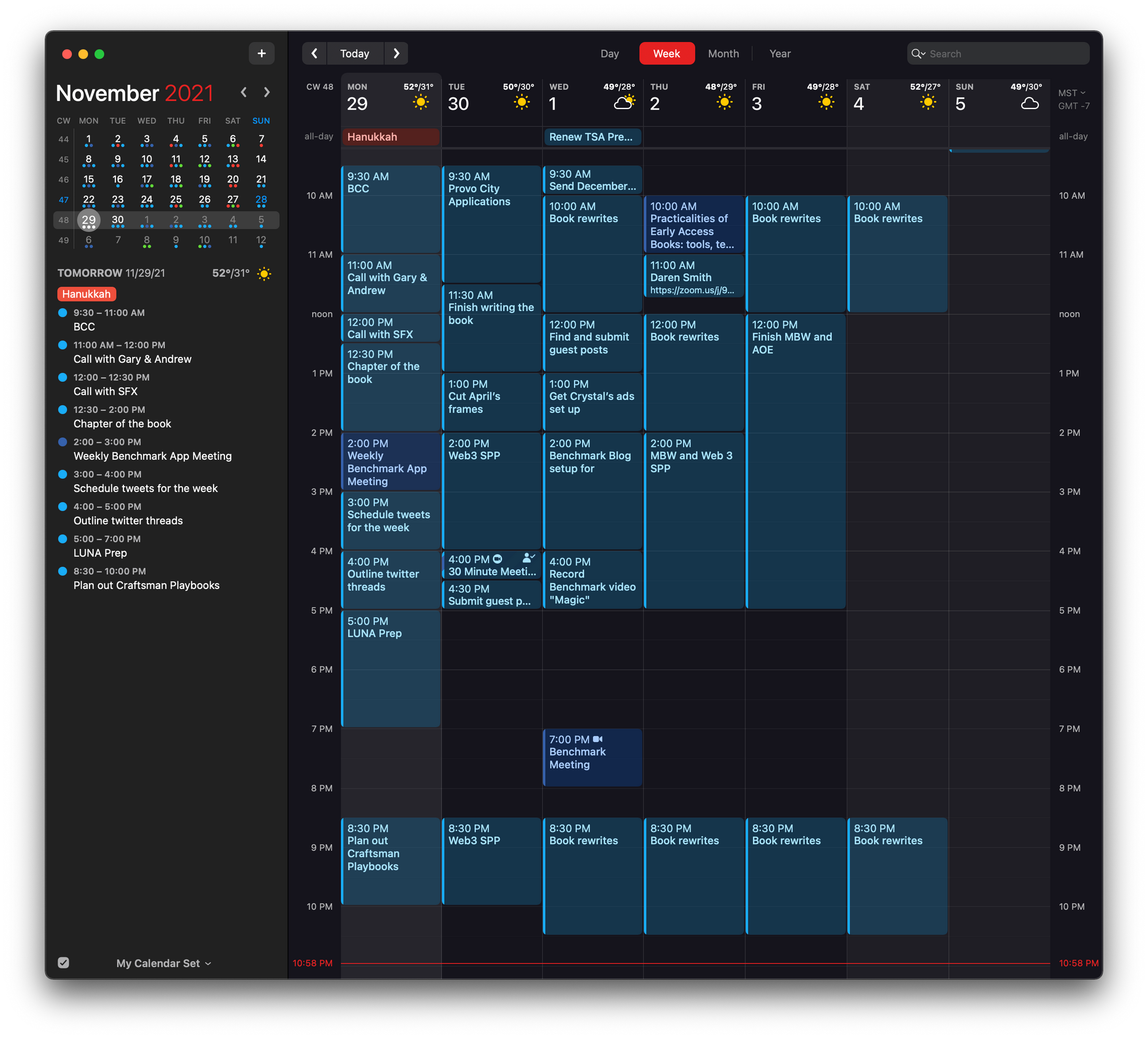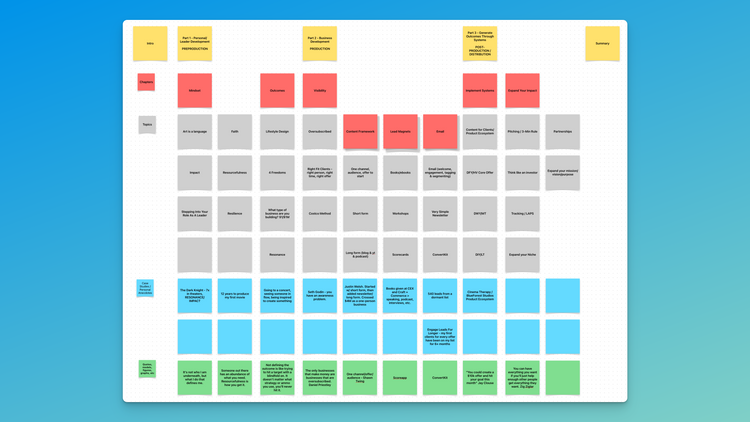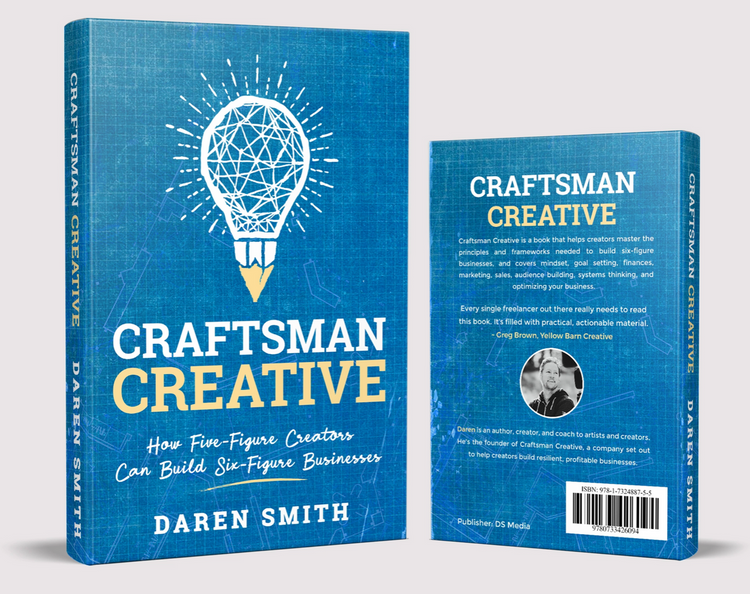Planning Your Life For Inevitable Success

When I started writing this book, I turned to my wife and said, "regardless of how many books I sell, how many new subscribers I get, or how many people read the words I write, if nothing changes in their life then I'll feel like I failed."
Yes, I actually said "regardless" in conversation with my wife.
I meant what I said. I've done everything I can to put actionable principles down on (digital) paper in hopes that you would be inspired to try anything that I've covered in this book in your own life and business.
This chapter has been one of the most transformational in my day to day life. It's helped me write this book in just over three months while prepping a feature film, producing a short film and a music video, and planning out a content strategy for Craftsman Creative for 2022.
Not to mention producing four seasons of television, starting two businesses, strengthening my marriage and my relationship with my three boys, and starting a consulting practice all in the last three years.
I don't list out these accomplishments to seem impressive, but to impress upon you how powerful the principles in this chapter are.
In one way we're talking about time management, but the scope is much bigger than that. This is about bridging the gap between knowledge and action. It's about owning that you're responsible for the outcomes in your life and your business. It's about raising your standards and taking massive action to create the life and business you've always wanted.
I want to share five thoughts from a mentor of mine, Tony Robbins, who I was able to spend some time with at his six-day, Date With Destiny event in 2019, as well as through his courses on creating lasting change and mastering your time.
These have impacted me in ways that would take thousands of words to convey, so I'll simply share these thoughts with you along with some thoughts of my own.
One reason so few of us achieve what we truly want is that we never direct our focus; we never concentrate our power. Most people dabble their way through life, never deciding to master anything in particular.
~ Tony Robbins
This idea is so empowering if you have the right attitude. You could take offense, or you could step up to the plate. Choose to focus, to concentrate, to master your life.
This is the first decision - to choose mastery. Choose to raise your standards. Choose to be different and to do more than anyone else.
If you talk about it, it’s a dream. If you envision it, it’s possible. If you schedule it, it’s real.
This is a more tactical thought, and below I'll cover the RPM system that Tony teaches to plan out your projects, your year, months, weeks, and days, and help you see the right next step to take at all times.
Deciding to commit yourself to long-term results rather than short-term fixes is as important as any decision you’ll make in your lifetime.
You'll notice in this book that I have never promised quick results. The main reason for this is because I haven't experienced them myself in my career. There have been times that I've immediately seen the difference in a new approach, but the results often lag for months or even years.
The goal I had to produce a feature film took twelve years! I attribute a ton of the achievement of that goal to this principle of being committed to long-term results rather than short-term tactics or hacks. It's served me well and I can't wait to see the results that come in years and decades from the decision to write this book.
Once you have mastered time, you will understand how true it is that most people overestimate what they can accomplish in a year – and underestimate what they can achieve in a decade!
This expands our vision to include a much longer timeline. What do you want your life to look like next year, but also in five or ten years?
What do you want to accomplish? Who do you want to become?
Go back and read your vision from the first part of the book and see what you're now inspired to add or change with this new perspective.
People who succeed at the highest level are not lucky; they are doing something differently than everyone else.
This was the key insight that changed my trajectory over the last two years. I realized that there were people who were operating at a different level than I was. They were achieving more, making more, connecting more, had more opportunities, and had a different approach to the way they lived their lives.
I was inspired by people like Tony Robbins, Seth Godin, Derek Sivers, Brene Brown, Barack Obama, Brian Clark, Steven Pressfield, Jim Collins, Sahil Lavingia, Steve Martin, Shonda Rhimes, Naval Ravikant, Brian Koppelman, Howard Marks, James Clear, Peter Diamandis, Dan Sullivan, and more, and wanted to figure out what made them different.
The answer: they took responsibility for the results in their life.
Now, let's look at one way you can take responsibility of your life, your calendar.
RPM Planning For Creatives
Tony’s signature productivity program that he teaches is known as RPM or the Rapid Planning Method.
RPM also, however, stands for Results-focused, Purpose-driven, Massive action plan.
He’s getting a lot of mileage out of that acronym…
The goal of this productivity system is to help you get the results that matter most and take responsibility for the results in your life and your business.
It’s not a to-do list.
It’s not about “getting things done”.
If you’re someone who wants to create, make, or produce – whether it’s products, or artwork, or creative projects – this is what RPM is best suited for.
While I can’t walk you through every step of the process (get the tapes for that) I do want to cover two parts that have played a massive part in my being able to get the results I've mentioned over the last two years.
Let’s start with the three aspects of the framework, and then how to apply them to your weekly and daily planning.
Results Focused
The biggest shift you’ll make using RPM is from thinking about tasks to thinking about results.
Tasks are what you do every day, results are what you want long-term.
I don’t know about you but I don’t get up in the morning excited about a long to-do list. I do, however, get extremely excited about making progress towards the big outcomes that I want in my life.
Shifting from “what do I have to do today” to “what do I want to achieve today/this week/this month/this quarter/this year” is massive and is the first step.
You begin by writing down some results you want in both your personal and professional life. 5-7 each is a good number. You did this back in the first part of the book.
If you didn't, take the time now to write them down. These serve as the results that you’re going to work towards and that will inform what you choose to do on a daily basis.
Purpose Driven
Once you’ve got your list of results you want to achieve, and before you start diving into action, we need to add in one extra step.
Not for arbitrary reasons. But because the difference between those that get a ton done and accomplish their goals is rarely because of how hard they work. It’s the purpose behind the goals that drive them to continue on.
With each one of the results that you’ve written down, take a few minutes to write down the reasons that the result is important to you.
Some questions may help:
- What will it mean to get this result?
- What will you become when you reach this result?
- What will this help you do?
- Who will it serve?
List out as many reasons that can inform the purpose behind the goal.
Only then can we shift into taking action.
Massive Action
Big goals are achieved by taking the appropriate level of action. Just today I had a phone call with someone who was asking me about what it would take to 10x my business – 10x more leads, 10x more value per customer, and 10x more revenue.
I was surprised that it wasn’t going to require 10x more action. It wasn’t going to take 10x more time.
It mainly requires thinking 10x bigger. Thinking about leverage. Thinking about the people you work with and the systems that are working in the background.
Massive action doesn’t always mean more time or more effort. It is more of a shift in mindset.
What this looks like is listing out all of the different ideas that will help you get closer to the result that you’re after.
This is where we can look at a weekly and daily practice of implementing this RPM system for your creative life and business.
Weekly RPM Planning Session
Each week, take 30-60 minutes to revisit your goals and the results that matter to you. Make any additions or take out any that aren’t serving you anymore or have been achieved.
Take a look at the results that you want to accomplish and pick a few that are most important to you for the week ahead.
Add to your list of reasons and expand the purpose that’s driving you to get that results.
Then write down all of the big actions you can take this week to get that result.
Do this step for each and every result that you want to work towards this week.
Then, to take it one step further, roughly map out your week. Pick a day or a block of time during the week that you can devote to that result. I’ve found it more effective to put all of the actions for one result into as few chunks as possible, rather than work on every result every day of the week.
Being able to go deep on something each day will get you more progress than spreading those tasks over the whole week.
Try to get one or two blocks of a few hours into your schedule for the week. Getting them into your schedule or calendar before the week starts will prevent other tasks or invitations from holding back your progress.
This is when you take control of your time. If you have your week scheduled before it starts, you're by default not available for last-minute meetings or random requests. This raises the bar for the things that do pop up - they better be good to replace what you've already scheduled for your week.
Here's what my calendar for the week generally looks like on Sunday night, before the week starts:

Fully booked! Want to schedule time with me? You'll have to schedule it next week.
Daily RPM Planning
Each day – and it doesn’t matter if it’s first thing in the morning, or at the end of the day in preparation for the next day – take 15 to 20 minutes to revisit your plan for the week and get more detail on the work you want to do for the day.
Schedule when you’re going to work on your project. Write down the people you need to communicate or follow up with. List out any other actions that will help you get the result you’re after.
I’ve started using Roam Research for this (in the past I’ve used both Evernote and Notion, but have landed on Roam as my current favorite in the last year), in conjunction with a physical planner. I get up early and do my morning routine, and then 15 minutes of RPM planning in a physical planner.
When I start working I put my tasks from the planner into Roam so that it lives on my second computer screen all day. I can then tick off the tasks that I’ve accomplished and capture new ideas or tasks throughout the day, and then more easily copy & paste anything that needs to be done tomorrow if I didn’t get to it today.
The Results Speak For Themselves
When you’re constantly reviewing your high-level goals and results for your life and business, you can’t help but focus on them and make progress. Exciting goals turn into exciting days working towards them.
Whatever system you choose, the important principles are to focus on the outcomes first and let the tasks be determined within that context, and to revisit your goals and results often to not only measure them but to keep them top of mind.
My hope is that this chapter inspires you to take responsibility for the results you're getting in your life and business.
Life doesn't owe you anything. Your industry and your market don't owe you anything. As much as you want to succeed, you've got to take responsibility for the results you're getting now, and the results you want in the future.
Try this system if you don't already have a productivity system that's delivering the results you want. Tweak it. Make it yours.
Identify the constraints in your business and take action. With a long-term approach to your success, doing more of what works and less of what doesn't, over time you're all but guaranteed to succeed.
NEXT CHAPTER >

< PREVIOUS CHAPTER








Member discussion